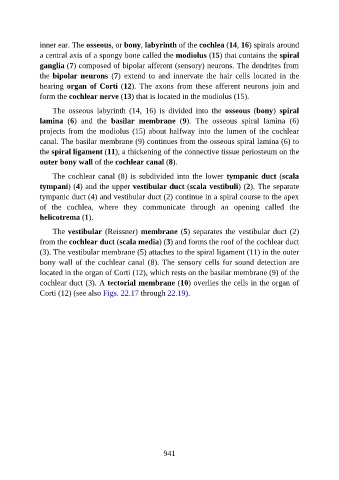Page 942 - Atlas of Histology with Functional Correlations
P. 942
inner ear. The osseous, or bony, labyrinth of the cochlea (14, 16) spirals around
a central axis of a spongy bone called the modiolus (15) that contains the spiral
ganglia (7) composed of bipolar afferent (sensory) neurons. The dendrites from
the bipolar neurons (7) extend to and innervate the hair cells located in the
hearing organ of Corti (12). The axons from these afferent neurons join and
form the cochlear nerve (13) that is located in the modiolus (15).
The osseous labyrinth (14, 16) is divided into the osseous (bony) spiral
lamina (6) and the basilar membrane (9). The osseous spiral lamina (6)
projects from the modiolus (15) about halfway into the lumen of the cochlear
canal. The basilar membrane (9) continues from the osseous spiral lamina (6) to
the spiral ligament (11), a thickening of the connective tissue periosteum on the
outer bony wall of the cochlear canal (8).
The cochlear canal (8) is subdivided into the lower tympanic duct (scala
tympani) (4) and the upper vestibular duct (scala vestibuli) (2). The separate
tympanic duct (4) and vestibular duct (2) continue in a spiral course to the apex
of the cochlea, where they communicate through an opening called the
helicotrema (1).
The vestibular (Reissner) membrane (5) separates the vestibular duct (2)
from the cochlear duct (scala media) (3) and forms the roof of the cochlear duct
(3). The vestibular membrane (5) attaches to the spiral ligament (11) in the outer
bony wall of the cochlear canal (8). The sensory cells for sound detection are
located in the organ of Corti (12), which rests on the basilar membrane (9) of the
cochlear duct (3). A tectorial membrane (10) overlies the cells in the organ of
Corti (12) (see also Figs. 22.17 through 22.19).
941

